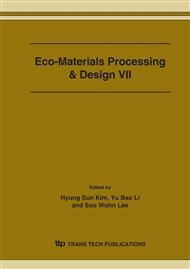p.562
p.566
p.570
p.574
p.578
p.582
p.586
p.590
p.594
Thermal Properties of Bi2O3-B2O3-ZnO Glass System
Abstract:
Oxide glasses having lower glass transition temperature are widely used in electric devices. The oxide glasses usually contain lead oxide. Recently, lead oxide glasses have been replaced with lead-free oxide glasses because of the environmental pollution. We investigated the thermal properties and the glass formation region in the Bi2O3-B2O3-ZnO ternary system. The results showed that the ratio of Tg/Tl of the bismate glasses is around 0.55, which is lower than the value of ratio 0.67, the two-third rule (Tg/ Tl=2/3)
Info:
Periodical:
Pages:
578-581
Citation:
Online since:
March 2006
Authors:
Price:
Сopyright:
© 2006 Trans Tech Publications Ltd. All Rights Reserved
Share:
Citation:


